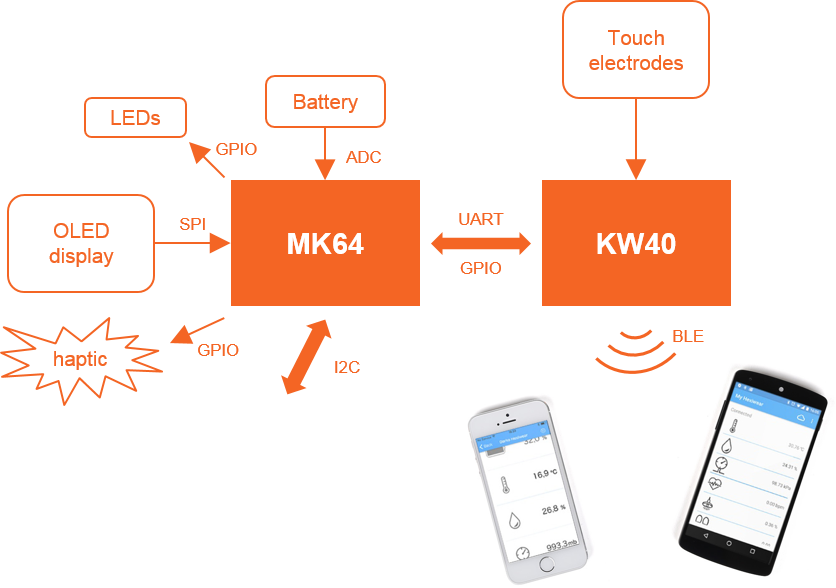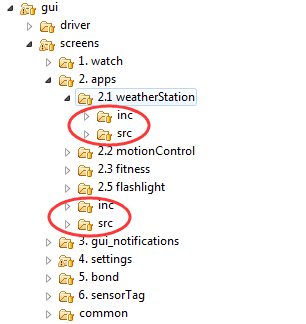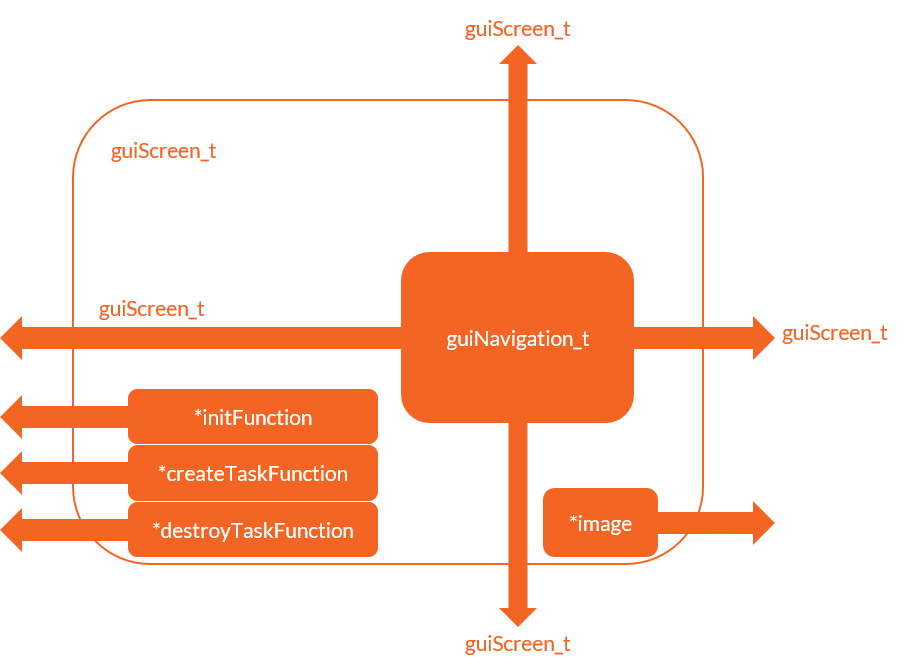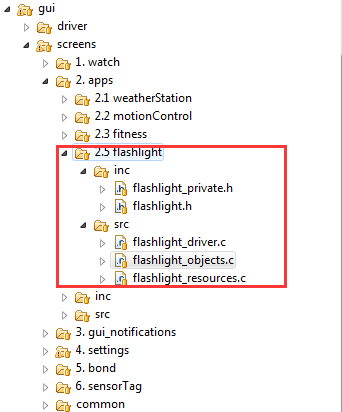GUI分析
界面结构体
screens下每一个文件夹对应一个功能显示界面。
watch是唤醒默认界面。app是在上面默认界面下点击menu,进入的界面。
上图中,每到一个文件夹下,显示的是src inc 对应的界面。
这是界面数据结构
struct GuiTtem这个结构体有五个成员:
- 上下左右四个按键对应的显示界面结构体指针
- 显示图片的地址
- 初始化函数
- 任务创建函数
- 任务删除函数
下面我们分析2.5 flashlight下的五个文件,来了解每一个界面的实现。
flashlight_objects.c
flashlightScreen 界面数据结构体定义
/** flashlight app screen */
guiScreen_t flashlightScreen =
{
.navigation =
{
.up = &gui_motionControl_coverScreen,
.down = &fitnessScreen,
.left = &appsScreen,
.right = NULL
},
.image = flashlight_screen_bmp,
.initFunction = flashlight_Init,
.createTaskFunction = flashlight_CreateTasks,
.destroyTaskFunction = flashlight_DestroyTasks
};flashlight_resources.c
界面显示图片数组定义
const uint8_t
flashlight_screen_bmp[18438] =
{
0x00,0x10,
0x60,0x00,
0x60,0x00,
......
}flashlight_private.h
界面显示图片数组声明
#define FLASHLIGHT_STACK_SIZE ( 0x400 )
#define FLASHLIGHT_PRIO ( HEXIWEAR_APP_PRIO )
extern guiImage_t
flashlight_icon;
extern const uint8_t
flashlight_screen_bmp[18438],
flashlight_off_bmp[4806],
flashlight_on_bmp[4806];flashlight.h
结构体成员函数声明
/**
* [flashlight_Init description]
* @param param [description]
*/
void flashlight_Init( void* param );
/**
* [flashlight_CreateTasks description]
* @param param [description]
*/
void flashlight_CreateTasks( void* param );
/**
* [flashlight_DestroyTasks description]
* @param param [description]
*/
void flashlight_DestroyTasks( void* param );flashlight_driver.c
结构体成员函数定义
void flashlight_Init( void* param )
{
GuiDriver_ImageAddToScr( &flashlight_icon );
GuiDriver_RegisterForNavigation( GUI_NAVIGATION_RIGHT );
}
界面如何切换

界面切换是根据KW40通过UART给MK64的信息来决定的。所以我们去寻找两个芯片的通信部分,也就是intf下,找到通信的内容,找到对内容的决策,就能知道界面怎么切换的。
intf/inc/host_mcu_interface.h
/** packet types */
typedef enum
{
packetType_pressUp = 0, /**< touch press up */
packetType_pressDown = 1, /**< touch press down */
packetType_pressLeft = 2, /**< touch press left */
packetType_pressRight = 3, /**< touch press right */
packetType_slide = 4, /**< touch slide */
......
}
全局搜索packetType_pressUp;
gui/driver/src/gui_driver.c
gui_status_t GuiDriver_ButtonsHandler(hostInterface_packet_t* packet)
{
gui_status_t
status = GUI_STATUS_SUCCESS;
guiNavigationDir_t navigationDir;
switch(packet->type)
{
case packetType_pressUp:
{
navigationDir = GUI_NAVIGATION_UP;
break;
}
......
}现在找到GuiDriver_ButtonsHandler这个按键处理函数啦!
static void PacketHandler( hostInterface_packet_t* self )
{
switch( self->type )
{
// buttons
case packetType_pressUp:
case packetType_pressDown:
case packetType_pressLeft:
case packetType_pressRight:
{
RTC_UpdateAlarm();
//haptic_Vibrate();
// if ( true == isWakingTouch )
// {
// isWakingTouch = false;
power_TurnScreenON();
// }
// else
{
GuiDriver_ButtonsHandler( self );
}
break;
}
......
}这是package信息contents处理函数;
/intf/src/host_mcu_interface_rx.c
static void HostInterface_RxTask( task_param_t param )
{
hostInterface_packet_t
tmpPkt;
while (1)
{
osa_status_t
status = HostInterface_RxQueueMsgGet( &tmpPkt );
if ( kStatus_OSA_Success == status )
{
#ifdef gHostInterface_TxConfirmationEnable
// acknowledge the packet reception
if ( 1 == ( tmpPkt.start2 & 0x01 ) )
{
HostInterface_EventSendOkPacketSet();
}
#endif
// handle the packet's content
PacketHandler( &tmpPkt );
}
}
}这是Host接口接受处理任务Task
函数调用流程如下:
HEXIWEAR_startup—>
status |= HostInterface_Init();—>
HostInterface_RxInit—>
OSA_TaskCreate ( HostInterface_RxTask,…)—>
PacketHandler—>
GuiDriver_ButtonsHandler—->
navigationDir(全局变量) = GUI_NAVIGATION_UP; GuiDriver_Navigation(navigationDir, NULL); —>
case GUI_NAVIGATION_UP: {ptrNewScreen = navigation->up;}
界面切换就发生在gui_driver.c下的GuiDriver_Navigation函数;
- end action for the current screen
- update the current gui item
- starting action for the new screen:
-
- 初始化 initFunction
-
- 绘图
-
- post-load action for the new screen createTaskFunction
界面
#
sensors : I2C
OLED : SPI
extern_flash :
intf : KW40 interface uart
notifications : Haptic feedback
power: 板级电量管理:OLED BATT


























 1万+
1万+

 被折叠的 条评论
为什么被折叠?
被折叠的 条评论
为什么被折叠?








